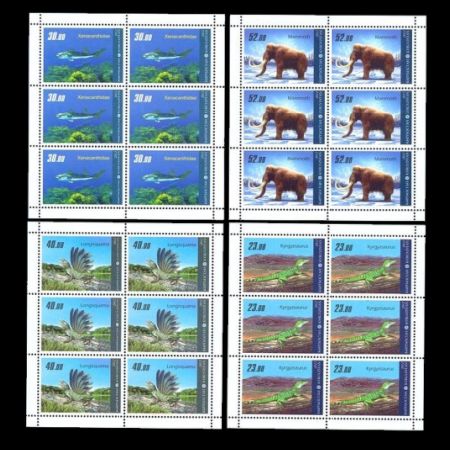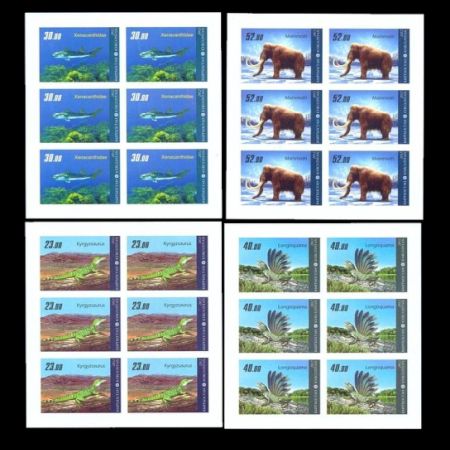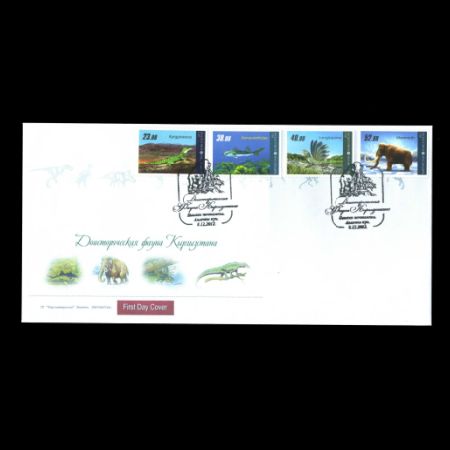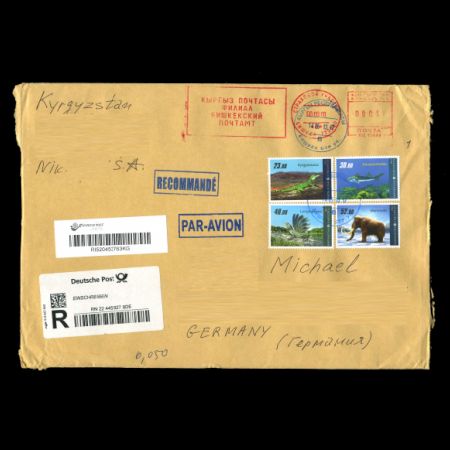Kyrgyzstan
2012
"Prehistoric animals"
| Issue Date |
08.12.2012 |
| ID |
Michel: Scott: Stanley
Gibbons: Yvert: UPU: Category: pR |
| Author |
Eldiyar Isakov |
| Stamps in set |
4 |
| Value |
S23 Kyrgyzsayrus
S30 Xenacanthidae
S40 Longisquama insignis
S52 Mammuthus |
| Size (width x height) |
40x28mm |
| Layout |
4 Sheets of 6 stamps each |
| Products |
FDC x 1 MS x4 |
| Paper |
chalky |
| Perforation |
14.25x14 |
| Print Technique |
offset |
| Printed by |
Publishing house "Belarusian Printing
House", Belarusia |
| Quantity |
6.000 sets (1.000 sheets) |
| Issuing Authority |
Ministry of Transport &
Communication Kyrgyz Rep |
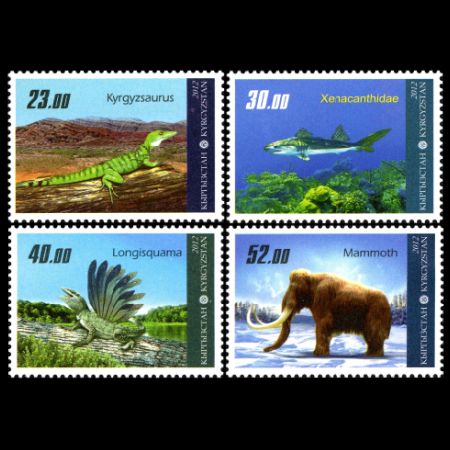
In December 2012 Post Authority of Kyrgyzstan issued set of four stamps - "Prehistoric animals", that shows prehistoric
animals who leaved on territory of the country in various geological
time from Triassic to Quaternary Period. Fossils of all these
animals are found in Madygen Formation, often called "Jurasic Park of
Kyrgyzstan".
The territory of Kyrgyzstan along with China, Mongolia, Uzbekistan and
Kazakhstan is among paleontologists haven for research. In the Jurassic
period, 160 million years ago, these areas were inhabited by various
prehistoric animals. During USSR times, Soviet
paleontologists found numerous remains of prehistoric animals and fish
in southern Kyrgyzstan Madygen Formation. These fossils can be seen in
paleontologic museum of Moscow.
Note: Similar
stamps are exist as imperforated.
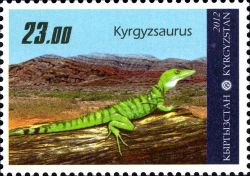 Kyrgyzsaurus
is an extinct genus of drepanosaurid archosauromorph known from the
Triassic of southwestern Kyrgyzstan. Kyrgyzsaurus is known only from
the holotype specimen, the anterior part of the skeleton including the
skull, cervical and anterior dorsal vertebrae, ribs, pectoral girdle
and skin imprints. The holotype was collected from the Madygen
Formation, dating to the late Carnian or the early Ladinian stage of
the late Middle or the early Late Triassic period, about 230-225
million years ago. Thus it represents the oldest known drepanosaurid.
Kyrgyzsaurus represents also the first Asian drepanosaurid genus to be
named. Kyrgyzsaurus was first named by V. R. Alifanov and E. N.
Kurochkin in 2011 and the type species is Kyrgyzsaurus bukhanchenkoi.
The generic name is derived from the name of Kyrgyzstan, and from Greek
sauros, "lizard", thus, the name means "Kyrgyzstan's lizard". Kyrgyzsaurus
is an extinct genus of drepanosaurid archosauromorph known from the
Triassic of southwestern Kyrgyzstan. Kyrgyzsaurus is known only from
the holotype specimen, the anterior part of the skeleton including the
skull, cervical and anterior dorsal vertebrae, ribs, pectoral girdle
and skin imprints. The holotype was collected from the Madygen
Formation, dating to the late Carnian or the early Ladinian stage of
the late Middle or the early Late Triassic period, about 230-225
million years ago. Thus it represents the oldest known drepanosaurid.
Kyrgyzsaurus represents also the first Asian drepanosaurid genus to be
named. Kyrgyzsaurus was first named by V. R. Alifanov and E. N.
Kurochkin in 2011 and the type species is Kyrgyzsaurus bukhanchenkoi.
The generic name is derived from the name of Kyrgyzstan, and from Greek
sauros, "lizard", thus, the name means "Kyrgyzstan's lizard". |
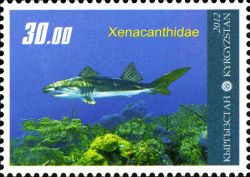 Xenacanthidae
is a family of prehistoric sharks in the order Xenacanthida. Some teeth
of the shark found in the Madygen Formation. An unusual aspect of this
finding was that the teeth found near the egg shell. Scientists first
stumbled upon this neighborhood. The research team, led by German
scientist Jan Fischer, examined the find and found that eggs and teeth
belong to different groups of sharks: xenacanthidae and hybodontidae.
Hybodontidae - extinct relatives of modern sharks and differ from them
only by small horn on its head in males. Henacanthidae also sharks
became extinct about 210-million years ago. They had the eel-like body
shape and protruding spine Xenacanthidae
is a family of prehistoric sharks in the order Xenacanthida. Some teeth
of the shark found in the Madygen Formation. An unusual aspect of this
finding was that the teeth found near the egg shell. Scientists first
stumbled upon this neighborhood. The research team, led by German
scientist Jan Fischer, examined the find and found that eggs and teeth
belong to different groups of sharks: xenacanthidae and hybodontidae.
Hybodontidae - extinct relatives of modern sharks and differ from them
only by small horn on its head in males. Henacanthidae also sharks
became extinct about 210-million years ago. They had the eel-like body
shape and protruding spine |
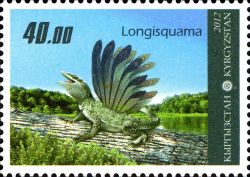
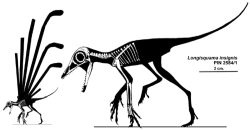 Longisquama
is an extinct genus of lizard-like reptile from Late Triassic period
(about 200 million years ago).. There is only one species, Longisquama
insignis, known from a poorly preserved skeleton and several incomplete
fossil as well as a few individual feather scalesimpressions from the
Middle to Late Triassic Madygen Formation in Kyrgyzstan. All
specimens are in the collection of the Paleontological Institute of the
Russian Academy of Sciences in Moscow.
Longisquama
is an extinct genus of lizard-like reptile from Late Triassic period
(about 200 million years ago).. There is only one species, Longisquama
insignis, known from a poorly preserved skeleton and several incomplete
fossil as well as a few individual feather scalesimpressions from the
Middle to Late Triassic Madygen Formation in Kyrgyzstan. All
specimens are in the collection of the Paleontological Institute of the
Russian Academy of Sciences in Moscow.
This is undoubtedly one of the most amazing animals. Small size, about
15 centimeters lizard along the back which protruded two rows of long
feather scales. The length of these scales is longer as the
length of the animal. Longisquama used them instead of a parachute.
Jumping down from the tree, she unfolded a fan of scales and slowly
lowered to the ground similar to a shuttlecock from badminton.
It was one of the first attempts to vertebrates to fly. there are was
no other animals who could fly rather than insects. Perphaps
insects were the diet of Longisquama, who preyed it by jumoing down
from the trees. |
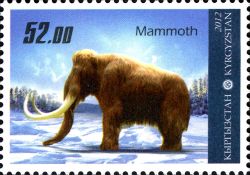 Mammuthus
- an extinct genus of mammal elephant's family, who lived in the
Quaternary period (2.6 million years ago to the present.). Mammoths
appeared in the Pliocene and lived 4.8 million - 4,500 years ago in
Europe, Asia, Africa and North America. Found numerous bones of
mammoths in the prehistoric Stone Age were also found drawings and
sculptures of mammoths, made by earlier humans . The main species of
these mammals do not exceed the size of modern elephants, but the North
American subspecies (Mammuthus imperator) reached the height of 5.5
meters and a weight of 12 tons, and the dwarf species (Mammuthus
exilis) and (Mammuthus lamarmorae) does not exceed 2 meters in height
and weight was up to 900 kg. Mammoths, unlike elephants, had a massive
body, shorter legs, long hair and long, curved tusks. The main types of
mammoths became extinct about 10 thousand years ago during the last Ice
Age. However, in 1993 an employee of the reserve on the island
Varngelya, Sergey Vardanyan, discovered the remains of mammoths on the
island, whose age was determined from 7 years to 3500. It remains a
special, relatively small subspecies that inhabited the island of
Wrangel at a time when the Egyptian pyramids were standing, and which
disappeared only during the reign of Tutankhamun and the heyday of the
Mycenaean civilization Mammuthus
- an extinct genus of mammal elephant's family, who lived in the
Quaternary period (2.6 million years ago to the present.). Mammoths
appeared in the Pliocene and lived 4.8 million - 4,500 years ago in
Europe, Asia, Africa and North America. Found numerous bones of
mammoths in the prehistoric Stone Age were also found drawings and
sculptures of mammoths, made by earlier humans . The main species of
these mammals do not exceed the size of modern elephants, but the North
American subspecies (Mammuthus imperator) reached the height of 5.5
meters and a weight of 12 tons, and the dwarf species (Mammuthus
exilis) and (Mammuthus lamarmorae) does not exceed 2 meters in height
and weight was up to 900 kg. Mammoths, unlike elephants, had a massive
body, shorter legs, long hair and long, curved tusks. The main types of
mammoths became extinct about 10 thousand years ago during the last Ice
Age. However, in 1993 an employee of the reserve on the island
Varngelya, Sergey Vardanyan, discovered the remains of mammoths on the
island, whose age was determined from 7 years to 3500. It remains a
special, relatively small subspecies that inhabited the island of
Wrangel at a time when the Egyptian pyramids were standing, and which
disappeared only during the reign of Tutankhamun and the heyday of the
Mycenaean civilization |
Products
References:
Wikipedia
Ukrafil Evening
Bishkek
Latest
update 12.11.2017
Any feedback, comments or even complaints
are welcome: [email protected] (you
can email me on ENglish, DEutsch, or RUssian)

